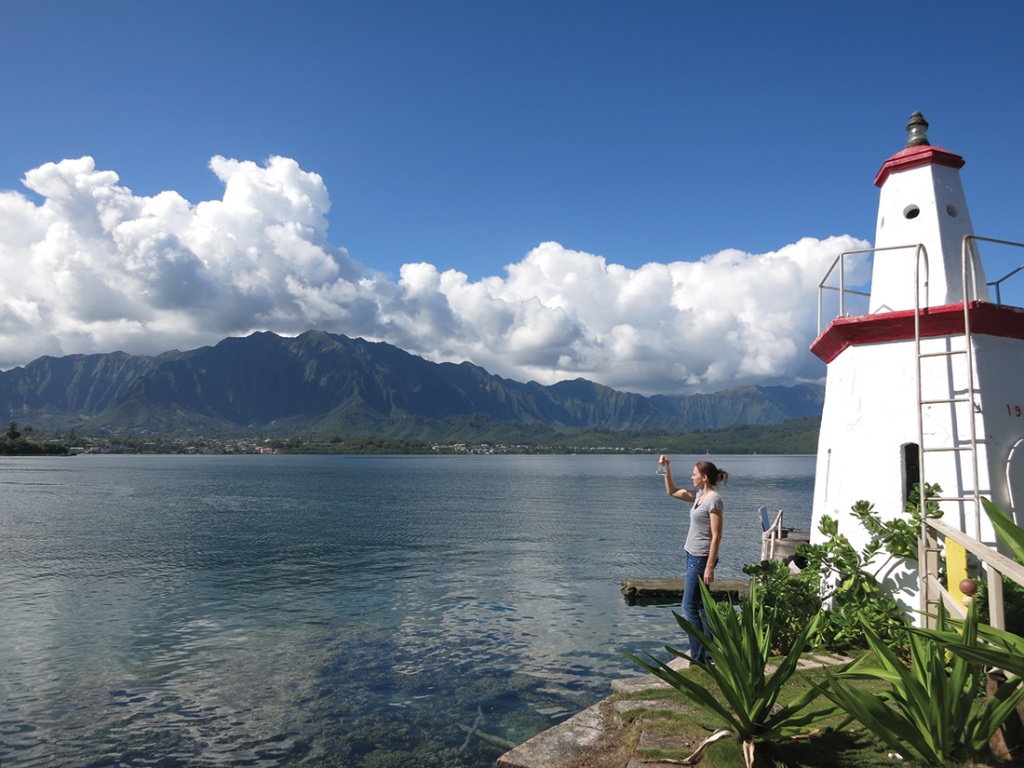
The Great Blue Unknown
A molecular biologist explores marine life beyond the surface
by Anidhya Jamwal (’17)
The vast blue ocean glistens as the sun rises over Moku o Lo’e Island, also known as Coconut Island. Its waves splashing against the coastline beckon curious minds to explore the bounty of life that resides within it. Amy Eggers (’03), a molecular biologist, responds to the ocean’s call as she water-commutes from the main island of Oahu to Coconut Island to reach the Hawaii Institute of Marine Biology (HIMB), an institute with facilities dedicated to marine research. Here at HIMB, she manages the Genetics Core Facility and the Confocal Microscopy Facility.
Because of the high diversity in marine life, the broad spectrum of Amy’s everyday role as a molecular biologist managing the two facilities is anything but routine. Amy’s day ranges from helping researchers design protocols that help identify the genetic codes of various organisms to developing high-resolution images of live specimens taken from the ocean in order to examine any changes in the various species of marine life.
Amy is now 13 years into her career as a molecular biologist, a career that first took shape in Bonnie Baxter’s Genetic Core class during her junior year at Westminster.
“It was there that I performed DNA sequencing for the first time,” Amy recalls. “I found it exhilarating that I was able to take such an intimate look at an organism’s genetic code.”
She traces her current work in managing the Confocal Microscopy Facility at HIMB back to her Biological Imaging Techniques class at Westminster, which prepared her to understand the concepts of microscopy in a world of ever-changing technology.
“These concepts are applied every day on the confocal microscope,” she says.
Amy’s current project involves assisting researchers in combatting coral bleaching: a stress reaction in corals that causes them to lose their colors due to increased temperatures in the ocean. Amy helps identify the genetic codes of such species by providing her expertise in order to highlight the underlying causes that result in the corals losing their color. The effects of this phenomenon are actually disastrous. The deaths of millions of corals could, in fact, result in significant loss to the tourism industry and pose a serious threat to the marine ecosystem.
Although coral bleaching is a serious problem, there is still hope: certain species of corals—called super corals—are surviving this phenomenon. The Assisted Evolution Project funded by Vulcan Inc., seeks to capitalize on such coral species to bring about the survival of corals through human-assisted evolution.
Amy’s ultimate dream is to increase the biotech capacity in Hawaii. She, along with her colleagues, is growing the locally available genetic-testing resources. “We want to expand high-complexity genetic-testing capabilities not only for research, but for clinical applications as well.”
According to Amy, the depths of the ocean certainly suggest the existence of unexplored life, and because Hawaii is an isolated and diverse ecosystem, it is a genetic researcher’s paradise.
About the Westminster Review
The Westminster Review is Westminster University’s bi-annual alumni magazine that is distributed to alumni and community members. Each issue aims to keep alumni updated on campus current events and highlights the accomplishments of current students, professors, and Westminster alum.
GET THE REVIEW IN PRINT STAY IN TOUCH SUBMIT YOUR STORY IDEA READ MORE WESTMINSTER STORIES
